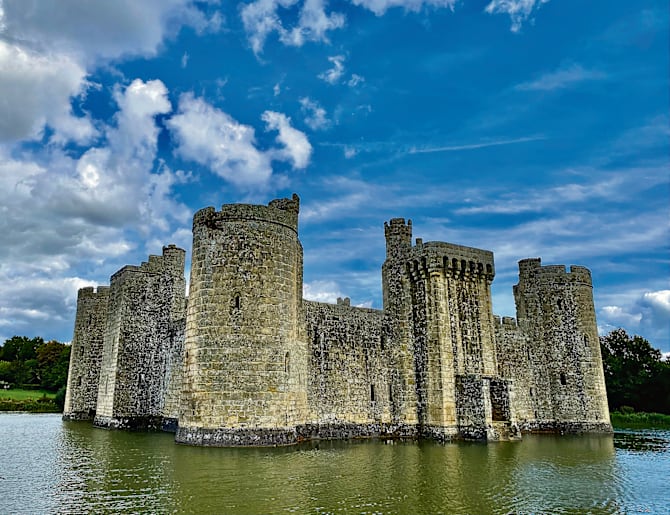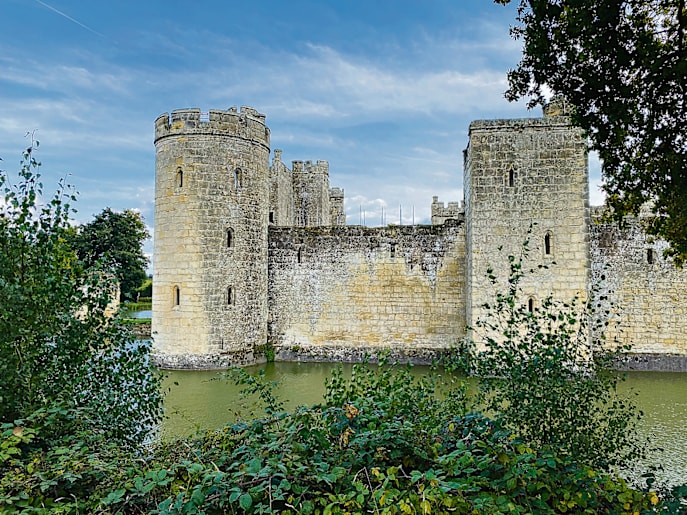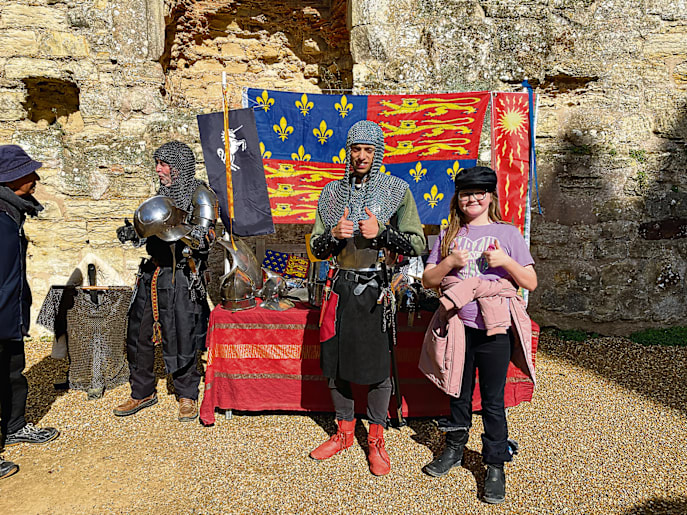

Bodiam Castle is an impressive piece of 14th century architecture.

Bodiam Castle is surrounded by a moat.

My daughter Willow with a guide in chainmail inside Bodiam Castle. He said boys began wearing the heavy headgear from around age 12.
Steam train journey to Bodiam Castle
EXPLORE WITH ME
Explore the United Kingdom with me.
Over the next four weeks I will show you around and tell you how to get the most out of your time in the UK.
A RIDE on a steam train through the Kent countryside in the north east corner of England is an experience on its own but this one goes further and transports its passengers back to the 14th century.
Our destination is Bodiam Castle, a moated piece of British history that is in excellent condition for its age.
But first we had a train to catch and that starts on the platform at Tenterden Town station.
The itinerary was for a 10.20am steam train to Bodiam Castle, a journey of around 45 minutes.
Along for the ride was my father Hank, sister Wendy, toddler niece and golden retrievers named Lola and Kyuss.
My sister was bang on time while we arrived a good 20 minutes prior to departure.
She breezed onto the platform clutching dog leads, a coffee cup and her toddler’s hand.
My niece was holding a small round plastic container.
‘My pickapilla, mine!’ she tells us, then opens the lid and inside it are two small green caterpillars.
‘It’s easier to just roll with it when you’re in a rush’ Wendy said rolling her eyes.
Bringing dogs along when going out seems to be the norm in the UK.
Lola and Kyuss joined us for dinner, during shopping trips and now they were sitting opposite us on a steam train.
Two carriages are set aside for people with pets.
“Let me see your bugs,” I asked my niece, she lifts the lid, one is wriggling but the other is still.
“Is your pikapilla ok?” I asked, already knowing the answer.
“It’s sleeping, shush,” she says.
I don’t think it was sleeping.
The steam train experience was made better by the efforts of rail staff who dressed up and played the part of 1800’s railway men.
Our daughter was invited into the engine room where she shovelled coal into the furnace that boils water to make the steam.
The carriages are as they were in the 1800s - comfortable cushioned seats with a table between them.
There was a canteen, and 45 minutes was enough time to watch the Kent countryside go by while sipping on tea and eating scones.
We pass stations at the towns of Rolvenden, Wittersham Road, Northiam and finally arrive at Bodiam.
It’s a short walk to the castle and before you realise it you are crossing the bridge across the moat.
Bodiam Castle is a two ‘paw print’ rated place on the Uk’s National Trust Website.
Lola and Kyuss are welcome because two paw prints means there are water bowls, dog bins and dog friendly walks.
But they aren’t allowed into the castle and so we take turns being outside with them.
The toddler’s ‘pikapillers’ get a pass.
Bodiam Castle was built by Sir Edward Dallingridge.
It was designed to be a home secure against marauders while impressing visitors.
Sir Edward was an experienced soldier and warrior knight who had fought against the French.
He was well aware of the threat of invasion and revolt.
While ruined, the castle is in surprisingly good condition for its age.
The moat, a common defence tactic, put distance between the enemy and those living inside its walls.
Defence also came in the form of weapons like swords, axes and English longbows.
There is a display near the castle’s entryway manned by two ‘knights’ and showing off replica suits of armour, chainmail and weapons.
“Feel how heavy this one is,” one says to me.
He’s holding a chainmail headpiece made from hundreds of metal loops.
The headpiece, called a mail coif, is worn during battle and practise sessions.
It’s heavy, really heavy … around four kilograms, and considering other heavy metal accessories are worn at the same time, rather impressive.
“How do they wear all of this and have the strength to fight?” I ask.
He tells me boys were made to wear the chainmail headpiece from the age of 12.
They trained to become accustomed to the weight and to be able to fight while wearing it.
The coat of arms belonging to Sir Edward is a helmet with a unicorn.
He wore a helmet with this emblem on it when going into battle.
Some of the castle’s defences are gun loops for hand held canons.
Guarding the entry point was important and a drawbridge was essential.
Bodiam Castle originally had three strong, heavy grates that could be lowered down on either side of a gateway to block it.
The parapet above the entrance would have concealed archers and the vaulted ceiling hid a gruesome defence tactic.
There are ring bosses or murder holes through which missiles can be dropped on attackers.
Tight and narrow stone spiral staircases lead to the top of the towers.
Space inside the castle walls was meticulously planned and food gardens were essential and a way for its residents to be self-sufficient.
Fireplaces were used for cooking and heating, and the kitchen housed bread and pastry ovens.
How you lived depended on your class, the high end of the hall leads to the main private apartments.
They were built with comfort in mind and set across two floors.
Again, meticulously planned, east facing windows captured the morning light and fireplaces provided added warmth.
Sir Edward and Lady Elizabeth sat in a space above the chapel called an oratory, believing the higher they were, the closer they were to God.
I found myself wondering what class I’d be had I lived in those times.
Would I be a lady with a handmaid or the person tasked with cleaning up after the gentry?
Our time is up sooner than I’d have liked and we leave the castle to catch the steam train home.
Dogs weary and one ‘pikapilla’ still fast asleep, we returned to Tenterden Town.
Bodiam Castle is steeped in history and a photographer’s dream but I’m content with electricity and grocery shops.
Visiting the past is a blast but it makes you appreciate modern convenience.





